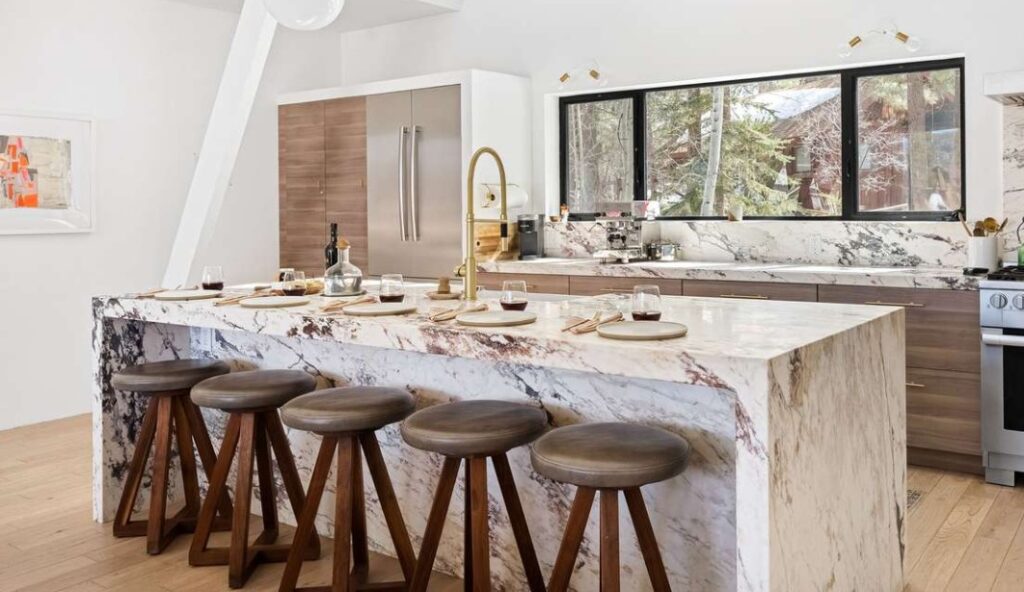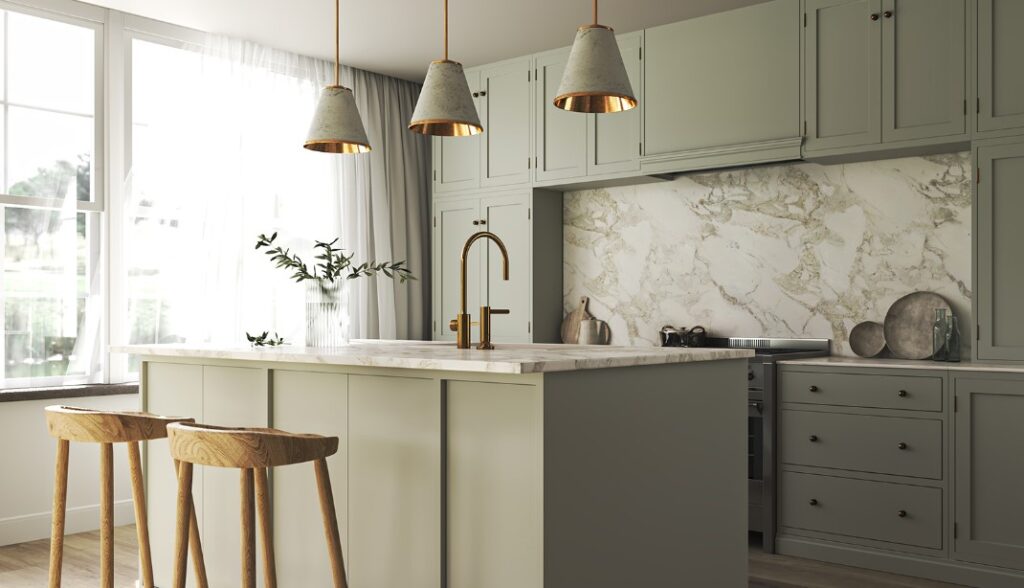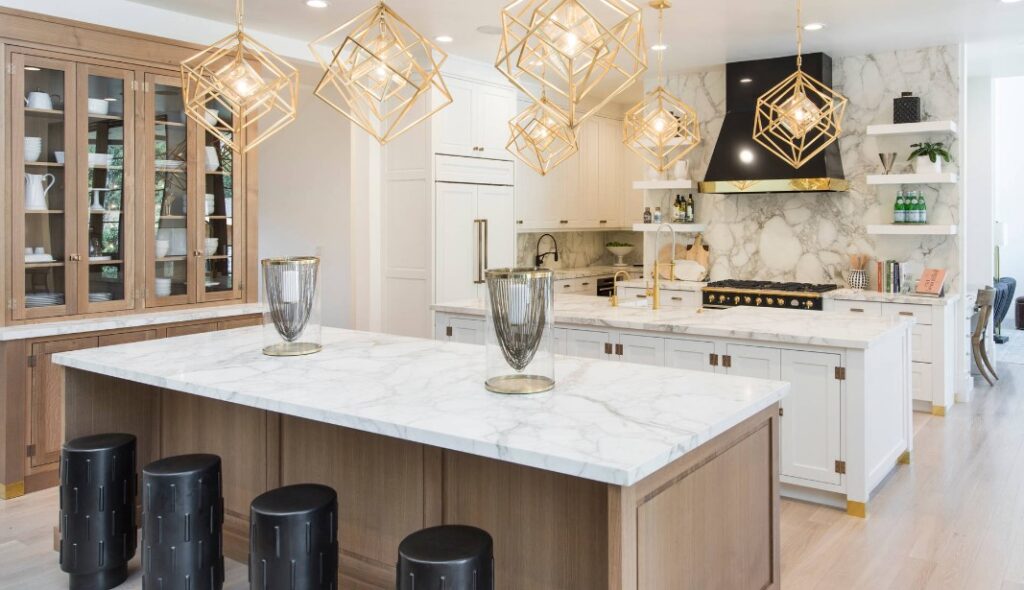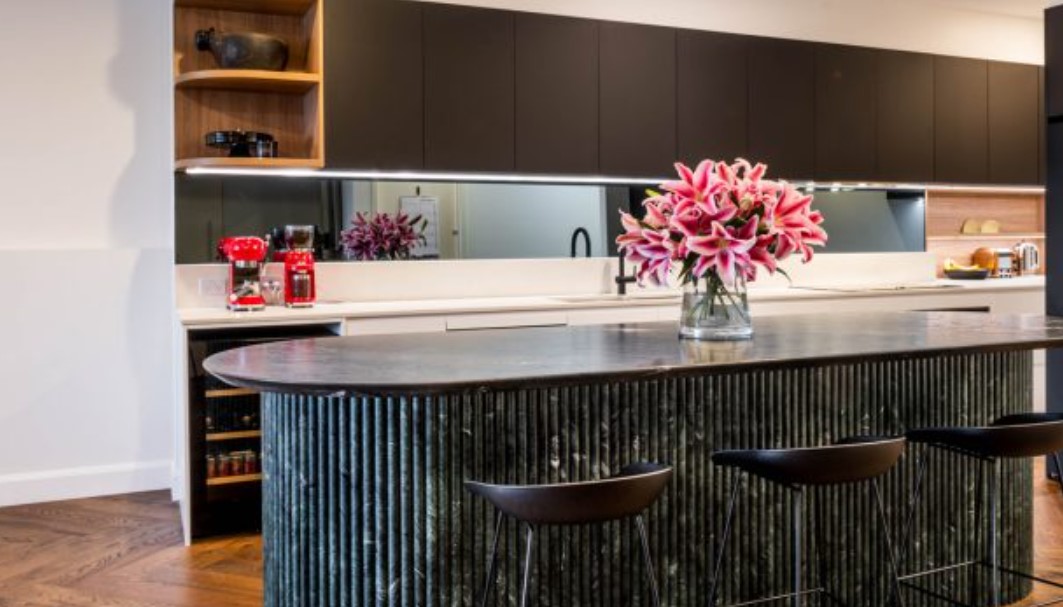The kitchen has evolved into the heart of the modern home, where functionality meets style in perfect harmony. Whether you’re renovating your current space or designing a new kitchen from scratch, embracing modern ideas can transform this essential room into a culinary oasis.
Introduction to Modern Kitchen Design

Modern kitchen design has evolved far beyond its primary function as a space for cooking. It has become a centerpiece of the home, blending functionality with aesthetic appeal to create a harmonious environment that meets the demands of contemporary lifestyles.
Definition and Characteristics
Modern kitchen design is characterized by clean lines, minimalist aesthetics, and innovative use of materials. It emphasizes simplicity, functionality, and a seamless integration of technology. Unlike traditional kitchens, which often feature ornate details and heavy cabinetry, modern kitchens prioritize efficiency and open spaces.
Importance of Functionality and Aesthetics
Functionality is at the core of modern kitchen design. Every aspect, from the layout to the choice of appliances and storage solutions, is carefully planned to optimize efficiency and usability. Modern kitchens are designed to streamline workflows, making meal preparation and cooking a more enjoyable experience.
Aesthetics play an equally crucial role in modern kitchen design. The use of sleek surfaces, neutral color palettes, and minimalist décor creates a sense of openness and airiness. This aesthetic approach not only enhances the visual appeal of the kitchen but also contributes to a feeling of serenity and modernity.
Evolution and Adaptation
Over the years, modern kitchen design has adapted to reflect changes in lifestyle and technology. Designers have embraced sustainable materials, energy-efficient appliances, and smart home technologies to meet the growing demand for eco-friendly and technologically advanced kitchen solutions.
In conclusion, modern kitchen design embodies the perfect balance between functionality and aesthetics. It is a space where innovation meets tradition, where culinary creativity flourishes, and where the heart of the home truly resides. Whether you’re renovating an existing kitchen or designing a new one, embracing modern design principles can transform this essential space into a stylish and efficient hub for daily living.
Layout and Space Optimization

Efficient use of space and optimal layout are pivotal in modern kitchen design, where functionality meets aesthetic appeal seamlessly. Whether renovating or designing from scratch, implementing smart layout strategies can transform a kitchen into a hub of efficiency and style.
Introduction to Layout and Space Optimization
In modern kitchen design, layout and space optimization are fundamental principles that dictate the efficiency and usability of the space. Beyond aesthetics, a well-planned layout ensures that every square foot is utilized effectively, catering to the practical needs of cooking, dining, and socializing.
Open Concept Kitchens
Benefits and Characteristics
Open concept kitchens have revolutionized modern living by integrating cooking spaces with living and dining areas. Removing physical barriers like walls fosters a sense of openness and connectivity, allowing natural light to flow freely and enhancing social interaction. This layout maximizes space utilization, making it ideal for contemporary homes where multifunctional spaces are valued.
Integration with Living and Dining Areas
By seamlessly blending kitchen, living, and dining spaces, open concept layouts create a cohesive environment that facilitates communication and family bonding. Designers often use islands or peninsulas to define functional zones within the open space, offering additional storage, workspace, and seating options while maintaining visual continuity throughout the home.
Galley Kitchens
Efficient Use of Narrow Spaces
Galley kitchens are a practical choice for smaller homes or apartments, utilizing two parallel walls for cabinets, countertops, and appliances. Despite their narrow footprint, galley layouts optimize space by minimizing wasted areas and creating efficient work zones. Design tips include maximizing vertical storage with tall cabinets, incorporating pull-out drawers for easy access, and strategically placing appliances to streamline workflow.
Design Tips for Maximizing Functionality
To enhance functionality in galley kitchens, designers prioritize ergonomic design and efficient storage solutions. This includes organizing kitchen essentials within arm’s reach, installing overhead lighting for task areas, and using reflective surfaces to enhance natural light and create a more spacious feel.
Island and Peninsula Layouts
Additional Workspace and Storage
Island and peninsula layouts are popular additions to modern kitchens, providing additional workspace, storage, and seating options. Islands typically feature a centralized countertop surrounded by pathways, while peninsulas extend from existing cabinetry or walls. These layouts enhance workflow by creating designated zones for food preparation, cooking, and casual dining, making them ideal for entertaining guests or everyday family activities.
Enhancing Workflow and Versatility
Islands and peninsulas serve as multifunctional hubs that enhance the kitchen’s versatility and aesthetic appeal. They can accommodate built-in appliances, such as cooktops or sinks, while offering ample storage underneath for cookware, utensils, and pantry items. Designers often customize islands with features like built-in wine racks, seating areas, or integrated charging stations to cater to specific lifestyle needs.
Ergonomics and Workflow
The Concept of the Kitchen Work Triangle
Efficient kitchen design revolves around the concept of the work triangle, which connects the sink, stove, and refrigerator—the three primary work areas. Designers optimize this layout to minimize unnecessary steps and create a fluid workflow that enhances productivity during meal preparation and cooking. By strategically positioning these elements, chefs can move seamlessly between tasks, ensuring a smooth and enjoyable cooking experience.
Design Considerations for Efficient Movement
In addition to the work triangle, designers consider traffic flow patterns and ergonomic principles when planning kitchen layouts. Ample aisle space between countertops and islands allows for comfortable movement and prevents congestion, particularly in kitchens where multiple people may be working simultaneously. This thoughtful approach to layout design enhances safety, efficiency, and overall functionality in modern kitchens.
Customization and Personalization
Tailoring Designs to Individual Needs
Personalization plays a significant role in modern kitchen design, allowing homeowners to tailor layouts and features to suit their unique preferences and lifestyle. Designers collaborate closely with clients to incorporate custom cabinetry heights, countertop materials, and storage solutions that optimize space and reflect personal style. Whether designing for a gourmet chef, a busy family, or an avid entertainer, customization ensures that the kitchen meets specific functional requirements while enhancing its overall appeal.
Incorporating Unique Features and Preferences
From specialty appliances and technology integration to architectural details and decorative finishes, personalized touches transform a kitchen into a reflection of individual taste and lifestyle. Homeowners may choose to showcase personal collections, incorporate heirloom pieces, or integrate cutting-edge innovations that enhance convenience and efficiency. This customization fosters a sense of ownership and pride in the kitchen as a central gathering place for family and friends.
Technological Integration
Smart Appliances and Connectivity
Technological advancements have revolutionized modern kitchens with the introduction of smart appliances and connectivity features. From refrigerators with touchscreen interfaces to voice-activated assistants and app-controlled lighting, these innovations enhance convenience, efficiency, and overall kitchen management. Homeowners can monitor and control appliances remotely, adjust lighting settings, and access recipe databases—all from the convenience of their smartphones or tablets.
Enhancing Convenience and Efficiency
Smart appliances not only streamline daily tasks like meal planning and grocery shopping but also contribute to energy savings and sustainable living practices. Features such as energy-efficient modes, temperature sensors, and automated settings optimize appliance performance while reducing utility costs. This integration of technology into kitchen design reflects a commitment to modern living and enhances the user experience through innovative solutions that simplify everyday routines.
Lighting and Ventilation
Task Lighting and Ambient Illumination
Proper lighting is essential in modern kitchens to enhance visibility, functionality, and ambiance. Task lighting, such as under-cabinet fixtures and pendant lights over work areas, illuminates countertops and cooking surfaces for safe and efficient meal preparation. Ambient lighting, including recessed lights and decorative fixtures, creates a warm and inviting atmosphere for dining and entertaining, enhancing the overall aesthetic appeal of the kitchen space.
Importance of Proper Ventilation in Kitchen Spaces
Effective ventilation is crucial in modern kitchens to remove cooking odors, grease, and moisture from the air. Range hoods or ventilation systems with powerful exhaust fans and grease filters help maintain air quality and prevent the buildup of indoor pollutants. Designers prioritize ventilation solutions that complement kitchen aesthetics while promoting healthy living environments for homeowners and their families.
Storage Solutions
Innovative Storage Options
Innovative storage solutions maximize space and organization in modern kitchens, catering to diverse storage needs and culinary preferences. Designers utilize every inch of available space, including vertical areas and hidden compartments, to store cookware, utensils, and pantry items efficiently. Pull-out drawers, lazy Susans, and adjustable shelving systems optimize accessibility and usability, making it easier to maintain a clutter-free and organized kitchen environment.
Maximizing Vertical and Hidden Storage
Vertical storage solutions, such as tall cabinets or shelving units, capitalize on ceiling height to accommodate bulkier items and infrequently used kitchenware. Hidden storage compartments, concealed within cabinet interiors or beneath countertops, offer discreet solutions for storing small appliances, cleaning supplies, and kitchen linens. By combining practicality with aesthetics, modern kitchens achieve optimal functionality and visual appeal through thoughtful storage design.
Environmental Considerations
Sustainable Materials and Practices
Environmental sustainability is a growing priority in modern kitchen design, influencing material choices, appliance selection, and construction practices. Homeowners and designers alike prioritize eco-friendly materials, such as reclaimed wood, recycled glass, and low-VOC finishes, that minimize environmental impact and promote resource conservation. Energy-efficient appliances, including ENERGY STAR-rated models and water-saving fixtures, further contribute to sustainability efforts by reducing energy consumption and water usage in the kitchen.
Energy-Efficient Appliances and Fixtures
Energy-efficient appliances and fixtures play a crucial role in modern kitchens, supporting sustainable living practices and reducing household operating costs. Features like programmable settings, temperature controls, and advanced insulation technologies optimize appliance performance while conserving natural resources. Designers educate homeowners on the benefits of ENERGY STAR certification and other eco-friendly initiatives, empowering them to make informed decisions that align with their environmental values and contribute to a healthier planet.
Cabinetry and Storage Solutions

Minimalist Cabinetry
Modern kitchens often feature minimalist cabinetry with clean lines and handleless designs. This aesthetic not only enhances the sense of space but also prioritizes functionality. Designers focus on maximizing storage capacity through innovative solutions like pull-out drawers, lazy Susans, and well-organized pantry spaces.
Smart Storage Solutions
Smart storage solutions are essential in modern kitchens to keep countertops clutter-free and organized. Utilizing every inch of available space includes thoughtful additions like vertical dividers for trays and baking sheets, under-cabinet racks for spices, and pull-out bins for recycling and waste management.
Countertops and Backsplashes

Quartz and Granite Countertops
Quartz and granite countertops are popular choices for their durability, resistance to stains, and timeless appeal. Maintenance involves regular cleaning with mild soap and water to preserve their luster and prevent damage from acidic substances.
Trendy Backsplash Designs
Backsplashes offer an opportunity to inject personality and style into the kitchen. Popular choices include classic subway tiles, intricate mosaic patterns, and textured ceramic tiles that complement the overall aesthetic. Choosing a backsplash that harmonizes with countertops and cabinetry enhances visual continuity in the kitchen.
Appliances and Technology
Energy-efficient Appliances
Energy-efficient appliances not only reduce utility bills but also contribute to sustainable living practices. Modern kitchens integrate appliances with advanced features like smart sensors, touch-screen controls, and energy-saving modes that enhance convenience and efficiency.
Innovative Kitchen Gadgets
Innovative gadgets streamline meal preparation and cooking processes, from smart refrigerators with built-in cameras to induction cooktops that heat food faster and more efficiently. These gadgets cater to modern lifestyles by saving time and improving overall kitchen functionality.
Lighting and Ambiance
Task Lighting
Task lighting plays a crucial role in modern kitchens, illuminating workspaces such as countertops, islands, and sinks. Under-cabinet lighting, pendant lights, and adjustable fixtures ensure optimal visibility for cooking tasks while adding a layer of ambiance to the kitchen environment.
Ambient Lighting
Ambient lighting sets the mood in the kitchen, creating a welcoming atmosphere for dining and entertaining. Dimmers, recessed lighting, and strategically placed fixtures enhance the overall aesthetic appeal while providing functional illumination throughout the space.
Color Schemes and Materials
Neutral Color Palettes
Neutral color palettes dominate modern kitchen design, offering versatility and timeless elegance. Shades of white, gray, and beige create a backdrop that allows for easy integration of accent colors through accessories like bar stools, pendant lights, and decorative items.
Natural Materials
Natural materials such as wood, stone, and metal finishes add warmth and texture to modern kitchens. Wood cabinetry, stone countertops, and brushed metal hardware create a tactile experience that balances the sleekness of minimalist design with organic elements inspired by nature.
Integration of Dining and Entertainment Areas
Kitchen Islands
Kitchen islands serve as multifunctional hubs for cooking, dining, and socializing in modern kitchens. They offer additional storage, seating options, and workspace extensions that cater to various culinary activities while enhancing the kitchen’s overall functionality and aesthetic appeal.
Breakfast Nooks and Dining Corners
Cozy breakfast nooks and dining corners provide intimate spaces within modern kitchens for casual dining and family gatherings. These areas maximize small kitchen layouts by utilizing corners and alcoves effectively while maintaining a cohesive design with the rest of the space.
Environmental Considerations
Sustainable Design Practices
Sustainable design practices in modern kitchens include using eco-friendly materials, installing energy-efficient appliances, and incorporating water-saving fixtures. These practices promote environmental responsibility while creating healthy and efficient living spaces that align with sustainable living principles.
Personalization and Trends
Customized Design Elements
Customizing modern kitchens allows homeowners to tailor the space to their unique preferences and lifestyle needs. This includes selecting bespoke cabinetry, integrating personal artwork or heirloom pieces, and incorporating design elements that reflect individual style and taste.
Current Trends in Modern Kitchens
Current trends in modern kitchens embrace innovation and technology, from matte black finishes and integrated appliances to smart home connectivity and voice-activated controls. Embracing these trends ensures that modern kitchens remain stylish, functional, and equipped for the demands of contemporary living.
Modern kitchens represent the epitome of functionality, style, and innovation in home design. By integrating key elements such as efficient layouts, sleek cabinetry, durable materials, and advanced technology, homeowners can create kitchens that not only meet their practical needs but also enhance their overall quality of life through thoughtful and modern design solutions.
